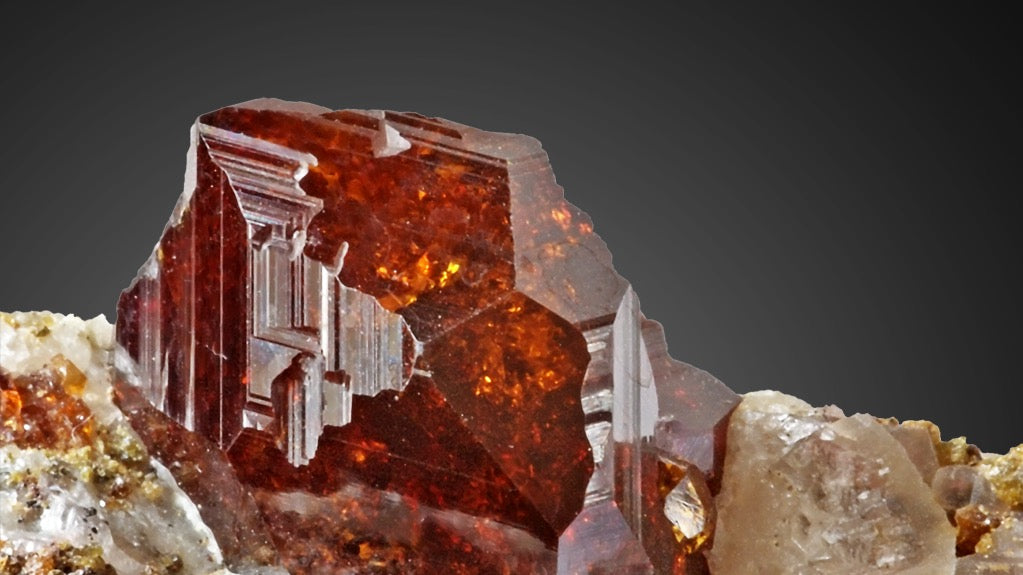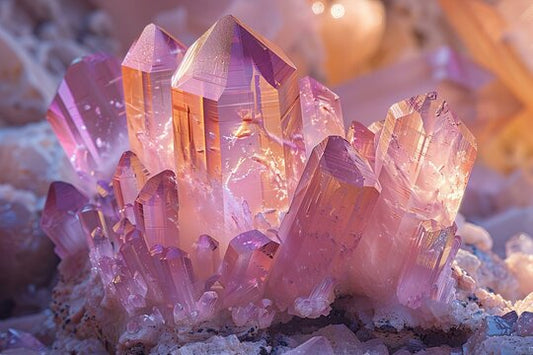
G is for Garnet
Natalie IfillIn this instalment of A-Z Gemstones Uncovered, we will be delving into the history of Garnets. Well-known for their connections to royalty, association with romance/passion and their gorgeous deep red colour.
 Stamped gold brooch and pendant, set with carbuncles (almandine garnets), England, about 1835. Photo: The Victoria and Albert Museum
Stamped gold brooch and pendant, set with carbuncles (almandine garnets), England, about 1835. Photo: The Victoria and Albert Museum
Even though Garnets are often called gemstones, this name is actually an umbrella term for a group of minerals consisting of stones with a similar chemical makeup. There are over 26 species of Garnets - out of all these, only five are commonly used commercially. Before I get into the history of these stones, I thought it would be best to do a little breakdown of these five:
- Almandine: This is one of the most commonly used Garnets ranging from dark red to black. They are usually opaque. These are relatively inexpensive and easy to source.
- Pyrope: These are the second type of Garnets most commonly used. The colouring is similar to Almandine; however, these stones are usually transparent with minimal flaws or inclusions. These tend to be highly desirable and more expensive compared to Almandine.
- Spessartite: These stones vary from orange to orange-red. Over recent years this stone has boomed in popularity.
- Grossular: The most varicoloured form of Garnet, which contains two beautiful varieties. A green variety known as Tsavorite and an orange-brown kind known as Hessonite.
- Andradite: Out of all the Garnets, this one is the most lustrous with variations such as the rare green Demantoid, yellow Topazolite and black Melanite.

Now let's get into the history of these stunning little gems...
Garnets have a fruitful history, with records showing they have been considered prized possessions since the Bronze Age (3100 BCE – 300 BCE). Excavations in burial sites uncovered mummified pharos wearing Garnet necklaces. The oldest Garnet to date was found on a buried man in 3000 BCE.
In Ancient Rome, signet rings were carved and contained Garnets. These rings were used as stamps for wax seals that secured letters and important documents.

Circa 1887–1878 BCE - Pectoral and Necklace of Sithathoryunet with the Name of Senwosret II
Centuries later, during the time Pliny the Elder (who was a Roman author and philosopher among his many occupation) in 23 CE to 79 CE, Garnets were among the most traded gemstones.
During the Anglo-Saxon period in Britain (410 CE to 1066 CE) Garnets were widely used. In 2009 news broke of a hoard of gold and Garnet military ornaments unearthed in a Staffordshire field. A large-scale conservation and research project began in 2010, carried out by the Birmingham Museum and The Potteries Museum. Out of the hoard, over 3,500 individually cut and mounted Garnets were discovered.
In the Middle Ages (around 475 CE to 1450 CE) Garnets were not only favoured by nobility and the clergy for their aesthetics but were used frequently as a cure for the Black Plague. The stone was believed to ward off danger, prevent arguments and ensure faithfulness.

Over the years, Garnets remained popular. Another boom of popularity increase happened during the Victorian Era (1837-1901), especially with "Bohemian" Garnets (now known as Pyrope); even though these first surfaced in the 1500s in Bohemia (now a part of the Czech Republic), Victorians were attracted to their glamorous, sophisticated vibe. These Garnets fitted in perfectly with their fascination for all things Gothic. Foiling the stones and enclosing the mounts fully at the back created the perfect appearance, especially when illuminated in candlelight. During the mid-1800s, Andradite Garnets were found in the Ural Mountains of Russia. These grew so much in popularity that it has now become a hallmark of Victorian jewellery.

So history lesson over! Now let's dive into Garnet's science and formation (don't worry, I'll keep it brief!)
As there are so many varieties of Garnets, it makes sense that they can form under a wide variety of geological conditions. With that being said, the majority grow under metamorphic processes.
Garnets formed in metamorphic rocks tend to do so under tremendous heat, pressure or chemical intrusions (sometimes all three!). This process is called metamorphism and often takes place when two tectonic plates are converging. Under intense pressure and high heat, a breakdown of chemical bonds begins causing minerals to re-crystallise. If the shale contains an abundant amount of aluminium and iron, Garnets tend to form. They start as small granules, growing over time when heat and pressure are present, eventually, they displace more and more of the surrounding rock.
However, Garnets aren't only formed in metamorphic rocks but also igneous rocks. Due to ancient volcanic eruptions and lava, Garnets can show up in rocks such as granite, basalt and rhyolite. Interestingly enough, Garnets can also be found in sedimentary sand. Due to their hardness, they can withstand chemical and erosive action, so, they often end up as visible pebbles in mineral-rich beaches or dunes!

Where are Garnets found?
Garnets are found all over the world, with each type in different locations. For example, the common depositaries are as follows:
- Grossular: Kenya, Tanzania
- Almandine: Sri Lanka
- Pyrope: Czech Republic, South Africa, the USA
- Andradite: Iran, Italy, Russia, the USA
- Spessartite: Australia, Israel, India, Nigeria, Myanmar
How did Garnets get their name?
Garnet originates from the Latin word 'garanatus' meaning 'seed like'. People believed that Garnets resembled the tiny red seeds of a pomegranate (I suppose this was before all the different colour variations of Garnets' were discovered).
 Pyrope Hair Comb (Photo: Smithsonian Institue)
Pyrope Hair Comb (Photo: Smithsonian Institue)

The name is also linked to Ancient Greek mythology. As the story goes Hades, fell in love and decided to capture his conquest, the goddess of vegetation, Persephone, bringing her to the underworld. Zeus, Persephone's father, found out and demanded she came home. Hades had no option but to listen to his brother, (yep he fell in love with his niece...) Wanting to ensure the safe passage home, he gave her a gift of a pomegranate. She accepted. Hades believed once she tasted the sweetness of the pomegranate, she'd be back. And he guessed right! Supposedly Persephone returns to Hades for three months every year forever. Garnets have been associated with eternity and has become a key symbol of love and safe passage.
There are many variations of this story but they all have a similar foundation.

5 facts about Garnets:
- Between 1889-1892, the Hunzas in northern Pakistan used Garnet bullets to fight the British. They believed that garnets would be more effective bullets than lead because they were red, like blood.
- You can get colour changing Garnets (a mixture of Pyrope and Spessartite Garnet) which are natural. They appear one colour when viewed in natural light and another when viewed under incandescent light.
- Non-gemstone quality Garnets found, are now used for industrial purposes, such as sandblasting and as a filtration media in water treatment facilities. When mixed with water, Garnet can cut through steel
- Garnets and Diamonds form under similar conditions. It is not uncommon to find these two stones together - some Diamonds have even been found inside Garnets.
- The worlds largest polished Garnet went up for auction in 2014 by Bonhams for an estimated price of £220,000 - £290,000. The piece remains unsold, but it is without a doubt a piece of serious art. Carved from an immense rough Garnet from Orissa, India, it weighs approximately 5,696cts (1.2 KG). It then opens up to reveal 456 diamonds, with a single octahedral brown diamond in the centre and 5 natural yellow diamond cubes. The piece consists of another 46 Almandite Garnets, 24 flat Garnets, crystal quartz, 18ct Gold and enamel. Manfred Wild sure created something outstanding.

(Originally posted on 11th October 2021)
If you enjoyed this post, check out the rest in our series: A-Z Gemstone's Uncovered.
We'd love to hear your thoughts, what's your favourite thing about Garnets or which gemstone would you like us to feature next! Comment below, like or share this post.



